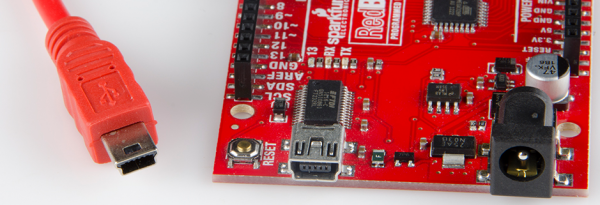RedBoard vs. Uno
USB Connectors and Drivers
Both the Arduino Uno and Redboard interface with computers via USB, but the connectors are different. The Arduino Uno uses the larger, square-ish type-B connector. Type-B USB connectors are often found on USB printers, or other devices where size is not an issue.
The RedBoard uses a mini-B USB connector. Mini-B connectors are lower-profile USB connectors, which might be found on cameras, MP3 players, and cell phones.
Obviously, you'll need a cable that matches the connector on the development board. The Arduino Uno would require an A to B cable, while a RedBoard would require an A to mini-B cable (or you could cover both bases with a Cerberus cable).
USB-to-Serial Converter
The second difference between the boards is how they manage to convert USB coming from your computer into a serial protocol the Arduino can understand. Arduino serial communication is critical for uploading sketches and sending/receiving information via the Serial Monitor. The Uno uses an Atmel processor -- the ATmega16U2 -- loaded with custom firmware, to convert USB to (and from) serial.
Before the Arduino Uno was released previous versions of the development platfurm used a dedicated USB-to-serial transceiver: FTDI's FT232RL. Call us nostalgic, but we really preferred the robust reliability of the FT232RL over the ATmega16U2 solution. So when we designed our own version of the Arduino platform, we decided to revert back to the FT232RL for our USB-to-serial needs.
About 99% of the time these ICs should be of no concern to your everyday Arduino hacking. Once drivers are installed, each should transparently convert data between your Arduino and computer. The difference between the two USB/Serial transceivers is most apparent when you're first connecting the board to your computer.
USB Driver Installation
For Windows users in particular, each board requires a unique driver to be installed before being usable. There are plenty of installation tutorials for both chips (our guide on installing FTDI drivers and Arduino's guide for theirs).
The most up-to-date version of the FTDI drivers can be downloaded directly from the chip manufacturer's webpage where they host installation guides of their own. There should be no shortage of driver-installation support out there.
Once the board is connected to your computer and the drivers are installed, the two chips should be almost invisible. For the most part, we don't really care how the Arduino communicates with our computer, just that it does.

